As part of the project, the Town has contacted the firm of KAS Environmental Science and Engineering. Lead, most likely from paint that has flaked off the building over the past 200 years, as well as fumes from vehicles powered with leaded gasoline, has contaminated approximately the top 18 inches of soil. This is their report, and proposal, on how to remediate the lead and the costs involved for the Town. To read their report, click here.
The following is the South Hero Meeting House Committee Response to a recent Front Porch Forum post by Ross Brown.
Ross Brown: “I’ve seen a few postings about the white meeting House. Here’s what I feel is fundamentally flawed about the whole project. The most recent development is the addition of a meeting place in the new town office. That’ll give us three library, gym and town office.”
Response:
- It was made clear in the 2019 survey that the people wanted the Meeting House restored.
- Library Community Room: often booked. Smaller occupancy fewer than 50 people.
- Folsom: Large venue in South Hero. Requires fees based on event, size, duration etc. Has full kitchen.
- New Town Office: Comfortable estimated occupancy 50. Has caterer’s kitchen available.
- SH Meeting House Community Room: Suitable for events & celebrations up to 88-188 people depending on the event type. Potential uses include weekly exercise classes, social dances, concerts, theatre performances, art gallery showcases & receptions, weddings, life celebrations and more. In other words, there is need and room for this additional community space.
Ross Brown: “The estimated “historical” restoration is 3.5 million”
Response:
- Build Phases #1 & #2 deals with just the current 1816 building. Budget is $1,300,000 (not 3.5 million). This is the budget submitted to Northern Borders Regional Commission for their Grant of $500,000.
- Fund-raising will continue for Build Phase #3: a 2-story addition on the north side of the building which will house an elevator, one accessible bathroom on each of the 2 floors, and a small caterer’s kitchen to support events on site. This phase adds water/wastewater to only this addition. Estimate to build to be determined.
Ross Brown: “There’s no plan to address the roof which is slate over cedar shakes. “
Response: There is a plan for the slate roof. The slate roof has been inspected by professional slate roofers and it is determined that the slates are falling off due to the old nails having rusted out. The plan is the slates will all be removed, the old cedar shingles removed, repairs made as needed, and then the slates that have passed the ring test will be reinstalled with new nails that will not rust. Slates that do not pass the ring test will be replaced with similar slates locally sourced if possible. The ‘ring test’ is when the slate is held vertically and a small hammer hits it gently, if a ringing noise results that means the slate is solid and in good condition. If no ringing results the slate is deemed flawed and will not be reused.
Ross Brown: “There’s no plan to modernize the windows their to be replaced single pane glass with storm windows. Which will have to be taken on and off as per season.”
Response: There is a window plan in keeping with an historical restoration project. The original historic windows will be removed prior to the building being moved so the new foundation can be safely built. The window spaces will be properly supported and boarded up during the move. Windows will be restored and any broken during the removal process will be made to replicate the original windows. Storm windows will remain installed year-round. The new HVAC system will provide comfortable heat & AC.
Ross Brown: “Historical grants locking you into federal government oversight etc etc.”
Response: Yes, there are requirements that go along with State and/or Federal grant funds. This is expected and the Selectboard was made aware of them before they agreed and signed any grant contract.
Ross Brown: “Let’s get to the financial aspect. Let’s say the building is worth 3.5 mil. The minute you rent it it will go on the tax rolls as non-homestead $2.59 per $100 of value. That equals $90,650.”
Response: The building will remain Town-owned. The final uses will be up to the Selectboard to decide including any fees that go along with the uses. The committee is not going to second-guess the Selectboard. The Town has the option to keep the 1st floor and it would remain untaxed. The Town has the option to rent the second floor in which case there would be some amount of rent revenue to off-set the second floor going onto the grandlist.
Bottom-line is that there are many factors the Selectboard has to decide upon. Note: The building has 1,748 sf per floor. Or, 3,496 total sf.
Ross Brown: “Given it is not a modernization it’s a restoration the maintenance will be endless. Conservative estimate $5,000 a year.”
Response: The current state of the Old White Meeting House is the result of decades of deferred maintenance. There is a price to pay for putting off maintenance. Going forward the Selectboard will have to decide on an annual budget allowance to put into the continuing maintenance of this building. The 1% Local Options Tax funds are slated to go toward Town buildings and may cover part or all of the maintenance. It could be $5,000 or possibly lower. This article describes the efficiency and sustainability of an historic building: https://southheromeetinghouse.org/energy-efficiency-in-historic-buildings .
Ross Brown: “Now let’s add heat, insurance, electricity , water and septic. You get the drift.”
Response: Estimates for electricity (heat & AC) and insurance are being researched by the committee. Currently the Town pays for liability for the building. Note: water/septic would not be included until the Phase #3 Addition.
Ross Brown: “The town of North hero rents a similar space for $125 a use. say you rented it eight times a month that’s $500. Now let’s multiply that by 12 . $6,000 per year income.”
Response: Having researched several similar Town venues across Vermont the Committee finds a wide range of fees that Towns charge including: by the sf, type of event, duration of the event, resident or non-resident etc. There is always a cleaning fee charged. Bristol may present the schedule of fees & usage that best suits the building. Ultimately the Selectboard will decide on this.
Ross Brown: “I’ve asked for a business plan many times only to be rebuffed by the chair David Carter and vice chair Sandy Gregg of the meeting house committee.”
Response: The committee’s priority has been stabilizing the building itself and Phases #1 & #2 will accomplish that. Regarding the business plan: you know the old phrase, ‘you get what you pay for.’ The committee consists of all volunteers. The business plan has slipped down the list due to concentration on privately raising funds so as not to impact our taxpayers. The business plan will get completed. To date, the business plan draft is 19 pages. Normally it could cost $8,000 – $10,000 for a business plan. The committee will produce one for free.
Ross Brown: “Not to mention I haven’t seen any huge groundswell of support financially from the community. What we have here is a committee of citizens who are making decisions that will affect taxes in perpetuity. Not to mention displacing an organization that really brought a sense of community to their little corner of South Hero”.
Response: Community support shows through the efforts of the SHMH Committee that has spear-headed the following grant awards: $67,000 in Planning Grants, $100,000 – Paul Bruhn Grant, $500,000 Northern Borders Catalyst Grant, $20,000 VT Historic Preservation Grant. There is currently $225,000 in the Town’s Meeting House account line (includes $100,000 ARPA funds). Additionally, the South Hero Foundation (SHF) has secured $100,000 from an Anonymous Community member with $25,000 to be awarded in 2025 followed by $25,000 increments over the next 3 years. Also, the SHF has raised a minimum of $70,000 designated to support the Meeting House Project. The SHF is also in talks with other private foundations and potential donors. This past week the SHF received a single check for $10,000. This is proof of community financial support.
Further, every building requires maintenance in perpetuity. Lack of it results in the current state of the Meeting House and Town Hall.
Regarding the future of Granny’s Attic: Since the building will be moved in order to build a new foundation, the Grannies had to vacate. The Town is dedicated to the future of this outstanding volunteer organization and is working in cooperation with the Grannies to formulate a plan to continue their good community work.
The SHMH Committee hopes this answers these important questions. Go to the project website: www.SouthHeroMeetingHouse.org for much more information and reports. Notes from the committee’s meetings are located here on the Town’s website.
Thank you!
South Hero Meeting House Committee
David Carter – Chair
Sandy Gregg- Vice Chair
Michael Carroll
Pamela Surprenant
Sarah Kjelleren
Terry Robinson
Carol Tremble
Beth Curtis
Mary Harwood – Consultant
This information is drawn from https://accd.vermont.gov/historic-preservation/planning/building-efficiency
Energy efficiency improvements to an historic building
How can historic buildings support my community’s efforts to reduce energy use?
Historic buildings are inherently sustainable. Constructed with traditional materials and methods, historic buildings have minimal carbon impacts. Approximately 11% of global C02 emissions can be attributed to new building materials and construction. Maintaining and rehabilitating existing buildings will extend the life cycle of these materials and reduce the growing carbon impacts of new construction.
With strategic planning that is building and site specific, you can assess the existing energy-efficient characteristics of your building and create a treatment plan that will reduce energy loss without compromising the interior air quality safety or structural condition.
Historic buildings were built to last and with maintenance and a few improvements we can reduce the C02 emissions from building use without shortening the life cycle of the existing building.
How can I weatherize my building while protecting its historic character?
Recognize that historic buildings were designed to be efficient when originally constructed, and these same elements continue to contribute to excellent energy efficiency today. Quick and inexpensive retrofits that generally will not impact the historic character of your building include installing storm doors and windows, adding weatherstripping, replacing incandescent light bulbs, replacing old appliances, and adding shade trees to the property. The replacement of windows and addition of insulation are not always the best generalized solutions, so please consult with your historic preservation partners for advice specific to your historic building and budget. Keep in mind there are some dangers in weatherization alterations that can do more harm than good by inadvertently trapping moisture, introducing materials with shorter lifespans, exposing occupants to toxins, damaging the structural integrity of a building, or undermining the inherent efficiencies put in place decades ago. Remember, each historic building is unique and requires individualized solutions for energy efficiency.
Guidance from the State Historic Preservation Office and the Preservation Trust of Vermont:
• Energy Conserving Features Inherent to Older Buildings White Paper
• Homeowner’s Guide: Contractors and Old Buildings
• Homeowners DIY Energy Efficiency Tips for Older Buildings
• Improving Energy Efficiency in Vermont’s Older Buildings Research Guidance
• Additional resources to help guide your sustainability planning: The Secretary of The Interior’s Standards For Rehabilitation & Illustrated Guidelines On Sustainability For Rehabilitating Historic Buildings
National Park Service Preservation Briefs
• Improving Energy Efficiency in Historic Buildings
• Whole Building Design Guide: Sustainable Historic Preservation
• Old House Online: How to Weatherize Your Windows
• Efficiency Vermont: When to Repair or Replace Your Windows
• Saving Windows, Saving Money: Evaluating the Energy Performance of Window Retrofit and Replacement
• Energy Conserving Features Inherent In Older Homes
f you need to comply with the Energy Code (RBES & CBES) and the changes may adversely affect an historic building, please complete the The Historic Buildings Exemption Form and submit to ACCD.projectreview@vermont.gov.
These drawings illustrate two different layouts of the first floor to provide a more accessible way of envisioning the use of this building once it is fully restored.
The “Event” scheme shows an occupant load of 84 people which is
below the 15sf/person calculation of 88 people.
The “Lecture” scheme shows a denser occupant load of 148 people
which is below the more concentrated code application for
assembly of 7sf/person. Using the 7sf/person, the maximum
occupancy comes to 188 people.
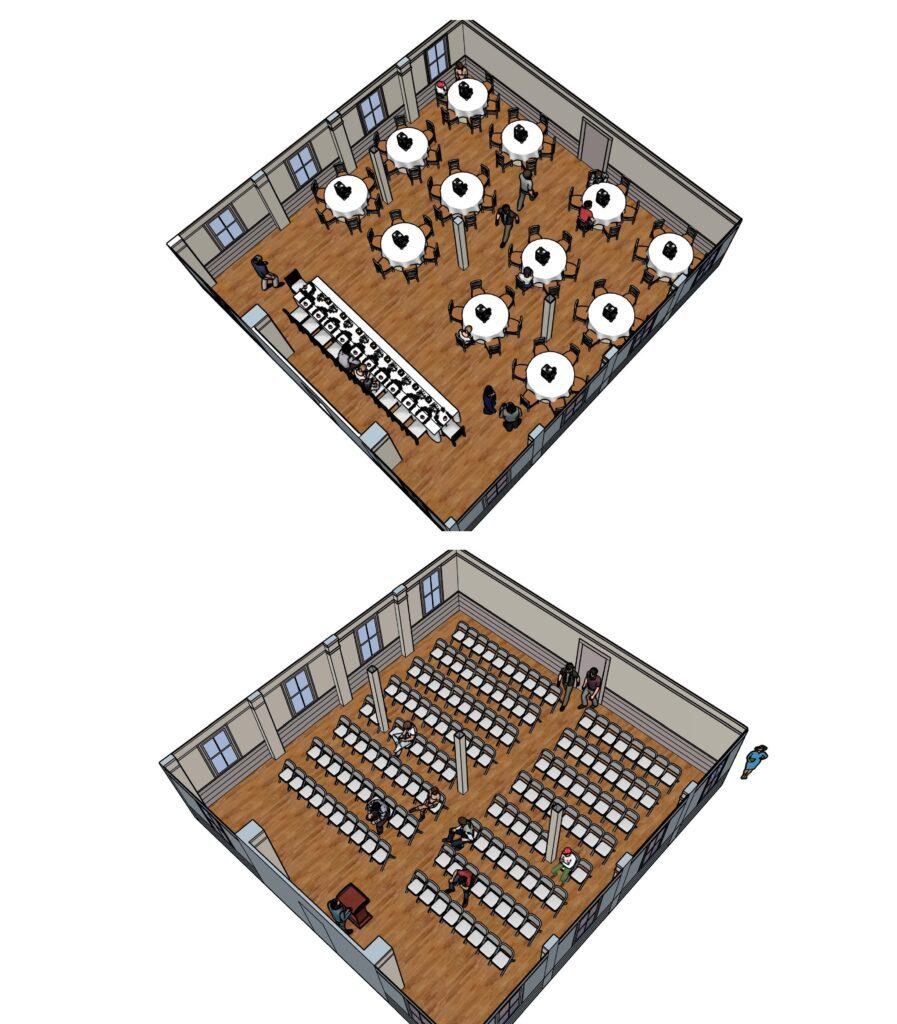
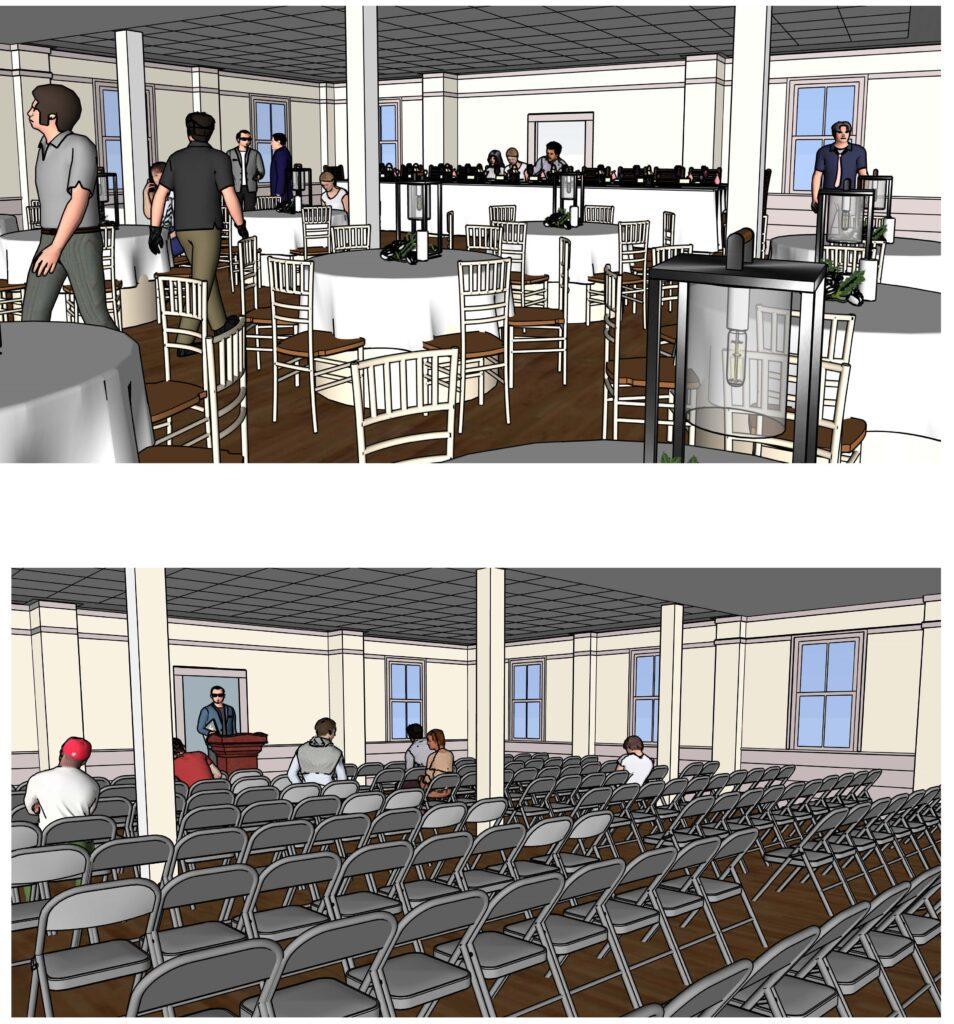
Download the images and text as a PDF.
For Revitalization of the South Hero’s Old White Meeting House
Architect’s Elevations showing covered stairway and ramp on rear of the building
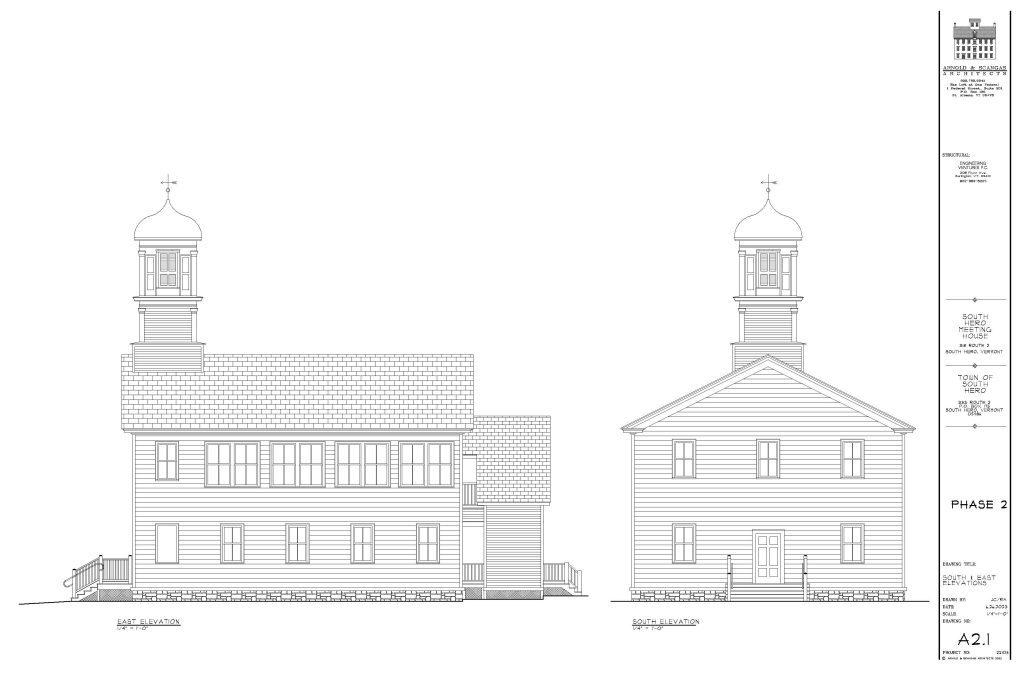
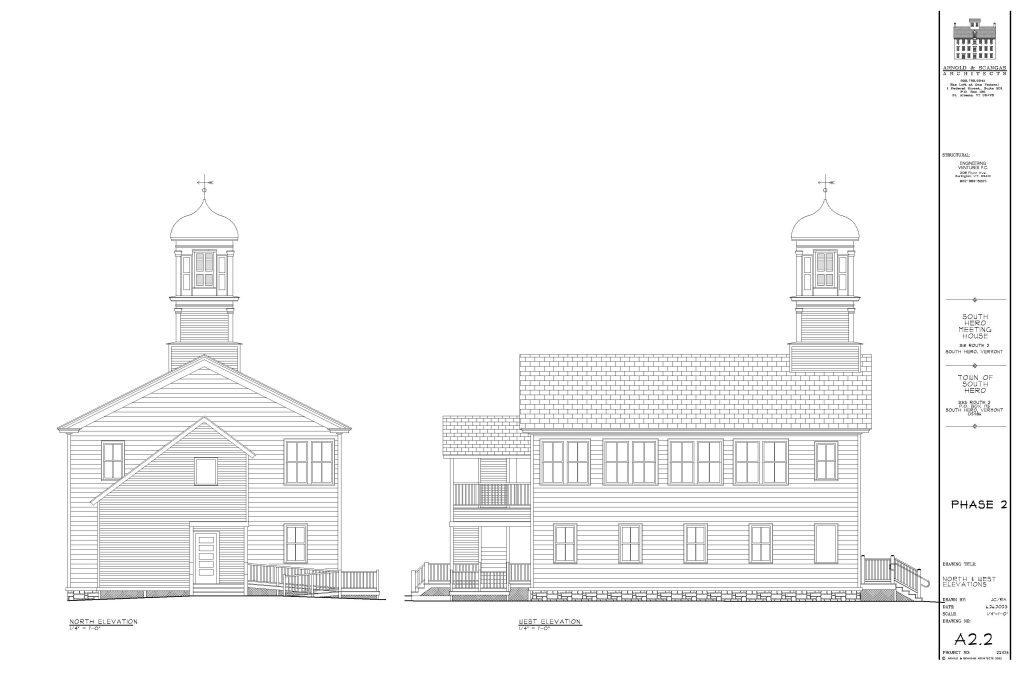
First and Second Floor Plans
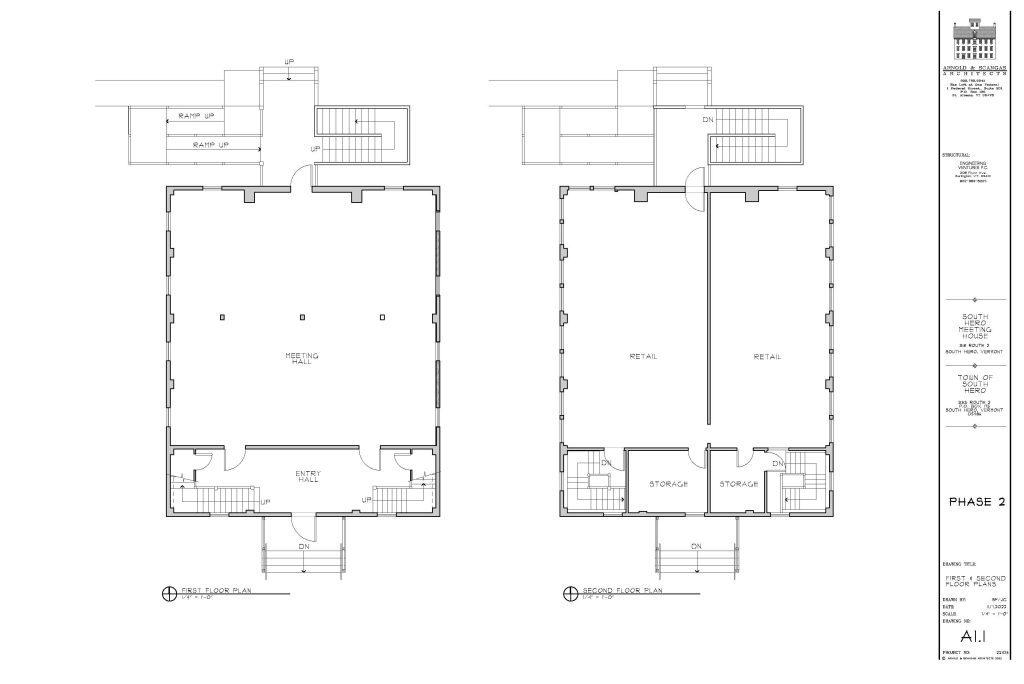
Architect’s Letter Detailing work to be completed – Click here
to view.
Construction Documentation Details at 50% of project – Click here to view.
The Meeting House, originally built in 1816 by volunteers, started its life as a church and Town Hall. When a new church was built on South Street in the 1850s, the elders donated the Meeting House to the Town of South Hero. We located the original deed, which features signatures of ancestors of many of today’s Town residents! If you read the list of names, you’ll recognize Robinson, Landon and others!
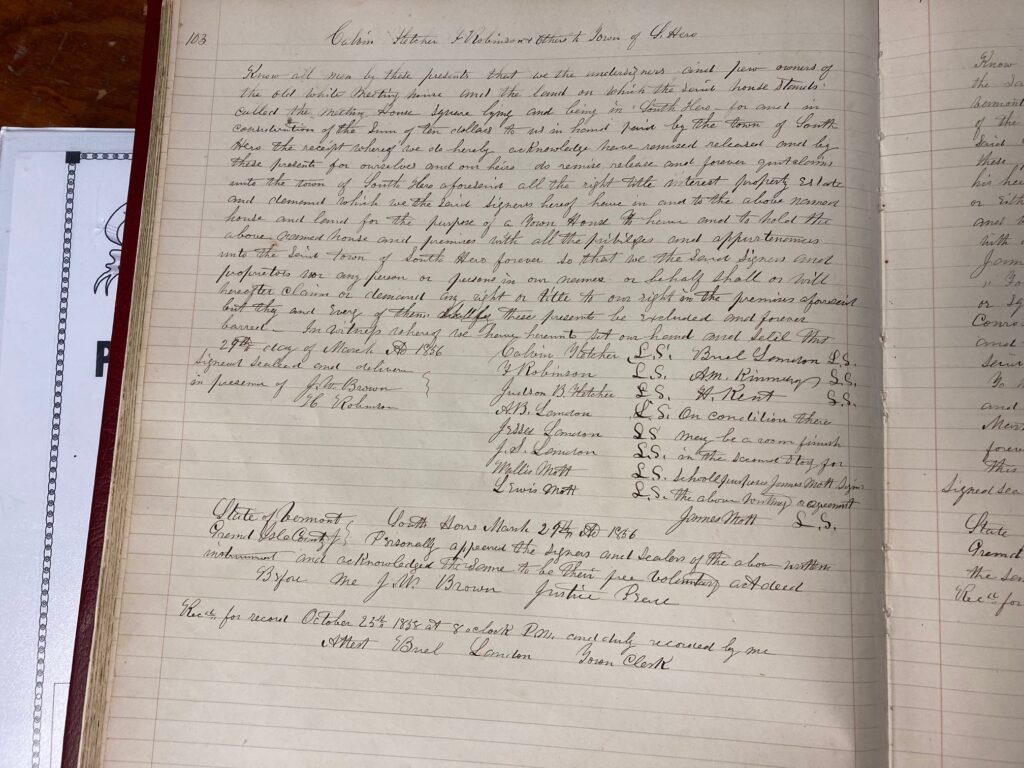
By Teresa Robinson (President South Hero Bicentennial Museum)
In 2013 when Paige Brownell was in fourth grade at Folsom School, her social studies class took a field trip down to the Old White Meeting House. Paige felt inspired to research more about the old church when she and her classmates noticed some historical details there. This is what Paige wrote:
“The Old White Meeting House was one of the first public buildings in town and was used as the first church, and as a place for people in town to meet for different reasons.
For many years it housed grades 5-8 until Folsom was built in 1949. We walked there and saw where people had written their names under the staircase. We think kids who went to school there in the past wrote them. It might have been that the kids got sent to the corner for being bad. We also saw a container of dried up glue in the closet. Maybe it was left over school supplies. We also saw evidence upstairs in Granny’s Attic that there used to be desks nailed to the floor and we saw a hole in the wall where the flag used to hang.
Bret Corbin met us when we got there. He told us a story about years ago when it was a church and a man used to sing beautifully. The man’s heart was broken when he was told they were going to have new services in the new church on South Street. He loved this church so much that he did not want it to be changed. I learned that this church has a lot of memories that people still cherish today.”
Today our town is embarking on restoring the existing foundation of the Meeting House and stabilizing the east wall by taking out the garage bays and putting back three windows like it used to look. Although it was built by skilled volunteer barn builders in 1816, the years have taken their toll and the building needs our renewed support. The town of South Hero applied for and was awarded a $100,000 grant from the Paul Bruhn Grant for buildings on the historic register. Matching funds are needed so anyone interested in supporting the South Hero Meeting House Foundation & Stabilization Project can donate by sending a check to the South Hero Foundation, Inc., PO Box 441, South Hero, VT 05486. The South Hero Foundation is a 501 (c) (3) non-profit organization.
Thank you for voting “YES” on Article 7 at the 2022 Town Meeting.
If you have questions email or call Sandy Gregg 802-372-4565.
“The Old White Meeting House is South Hero’s Norman Rockwell postcard of a quaint Vermont town whose people gather with ingenuity and foresight to support each other and turn daunting obstacles into heartfelt accomplishments. The church was the first outcome of countless coordinated good deeds. Imagine how many generations of people have been away from South Hero in both good times and bad, only to return and immediately feel at ease, at home, as they gaze up to an old friend with her cupola proudly in the clouds. We have very few historic public buildings here in South Hero. They deserve our appreciation and care.”
Those words were written by Bret Corbin in 2012, a love letter to South Hero, supporting the Old White Meeting House Cupola Restoration Project. His sentiments still ring true today as we embark on restoring the existing foundation of the Meeting House and stabilizing the east wall by taking out the garage bays and adding three windows and clapboard to match. Although it was built by skilled volunteer barn builders in 1816, the years have taken their toll and the building needs our renewed support. The town of South Hero applied for and was awarded a $100,000 grant from the Paul Bruhn Grant for buildings on the historic register. The grant requires matching funds so anyone interested in supporting the South Hero Meeting House Foundation & Stabilization Project can donate by sending a check to the South Hero Foundation, Inc., PO Box 441, South Hero, VT 05486. Please be sure to mark the check and envelope with “South Hero Meeting House Foundation Project.” The South Hero Foundation is a 501 (c) (3) non-profit.
South Hero’s Meeting House, the oldest municipally owned building in Grand Isle County, is up for a vote at Town Meeting on Tuesday, March 1. Article 7 will provide the funds to match a $100,000 grant from Preservation Trust of Vermont’s Paul Bruhn Grant program, which is through the National Parks Service to construct a new foundation and stabilize the east wall of the building.
The first Phase of the planned renovation and revitalization of this building will include jacking up the building so a full cellar and new foundation can be poured as well as stabilization of the east wall, which has sagged considerably over the years from the garage bay doors installed in the 1950s.
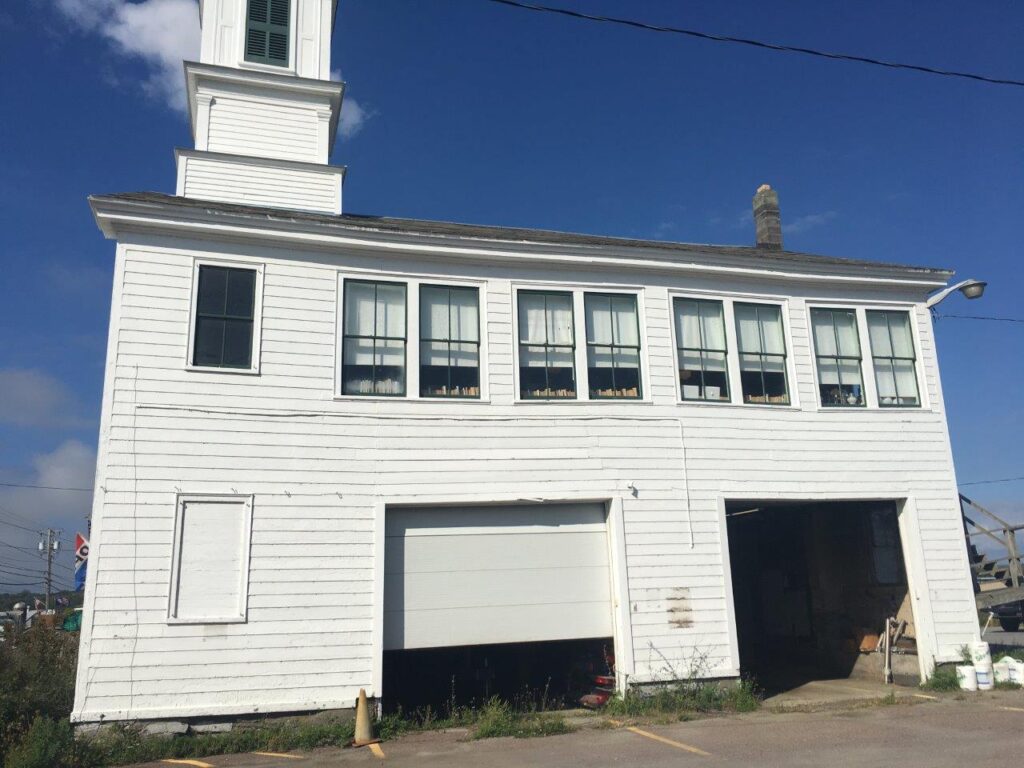
Without this foundation and stabilization work, the future of the building is unclear. Several years ago, the Granny’s moved heavy objects out of the east side of their shop as the roofline began to visibly sag.
Your vote in favor of Article 7 will start us on the path to bringing this great building back to a full life. Winterization, heat, plumbing, and an addition to provide accessibility as well as office space, which are proposed for future Phases of revitalization, will create a vibrant community asset that will be a complement to the proposed recreation park adjacent to the Meeting House.
This first step in a long revitalization process will ensure that the Granny’s have a safe space for their shop. The full basement, which is part of the project, will create storage for the Town and the restored subflooring will create a useable shell on the first floor.
Please vote yes on Article 7 on Tuesday, March 1. Without your support of this Article, the Town may not be able to fulfill the obligations of the $100,000 grant. Your donations to this project (with checks made out to the South Hero Foundation, Inc., PO Box 441, South Hero, VT, or made online through this site) will also help round out the full match for this project, which has a $275,000 budget. Thank you!